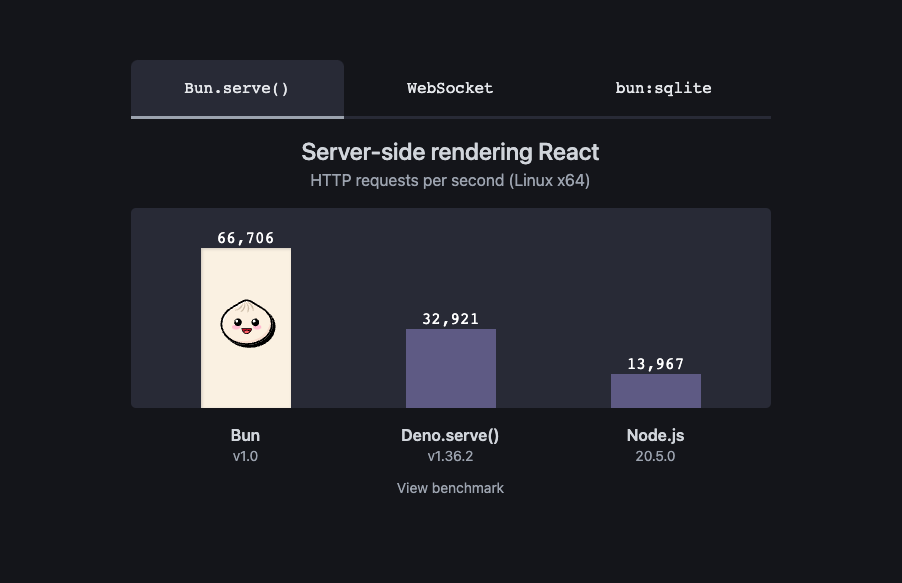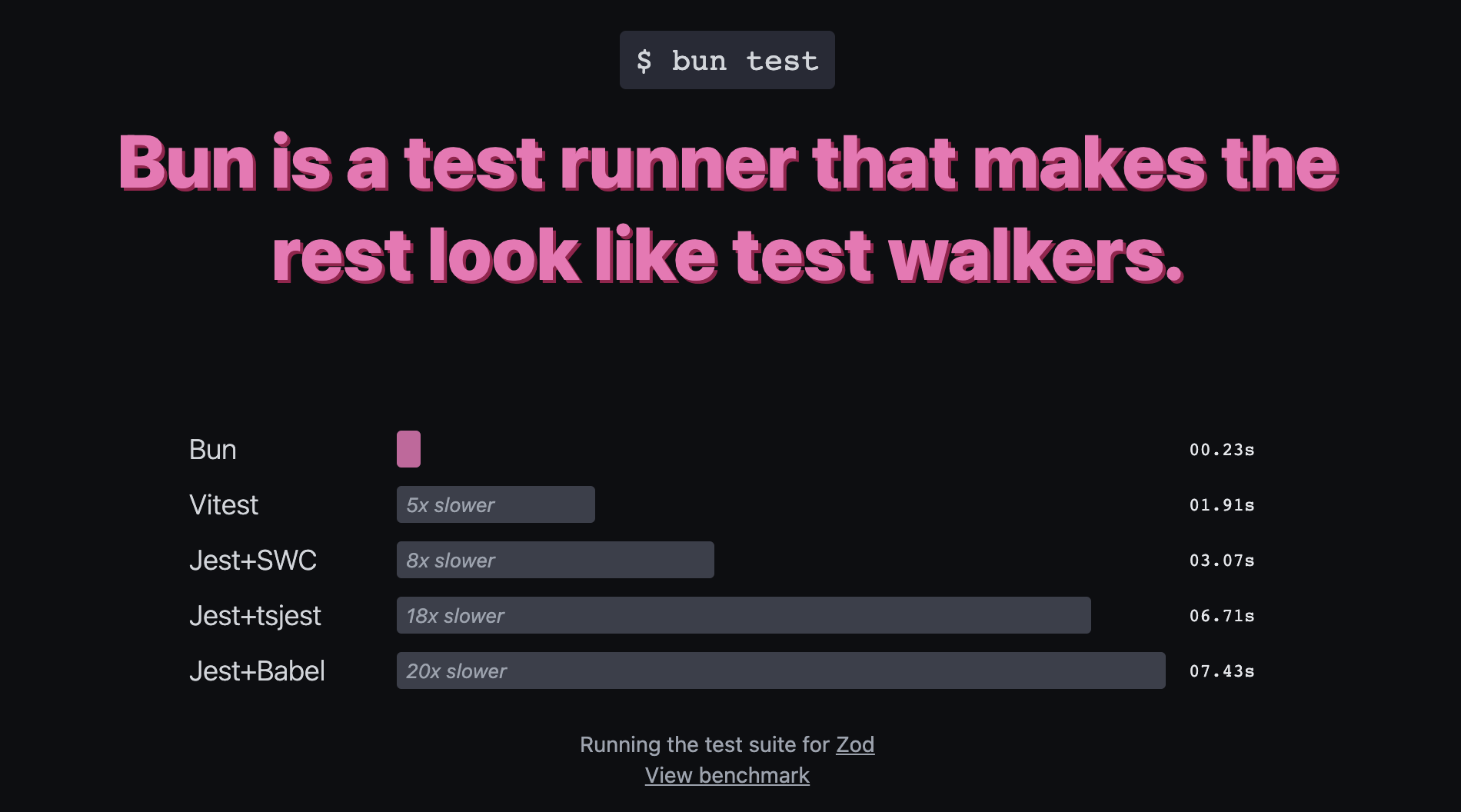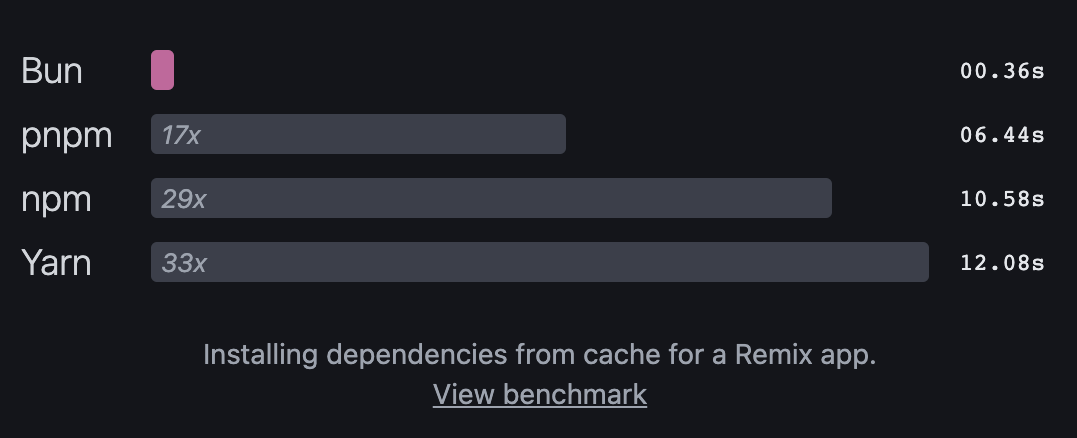Bun vs. Node.js: The Future of JavaScript Runtime?
September 20, 2023 • 0 minute read •

JavaScript has a new kid on the block: Bun. Designed for the modern JavaScript landscape, it promises a faster, more streamlined developer experience. If you've faced slow dependency installations, navigated complex module rules, or sought a faster runtime, Bun could be the solution.
This article explores Bun's unique features and why developers should consider it. Let's get started.
Design Goals and Features of Bun
Diving into Bun, let's break down its primary design goals and features:
Bun is Fast
Bun's design philosophy centers around efficiency. It achieves this by extending JavaScriptCore, the engine developed for Safari. From the performance benchmark on the Bun website, Bun.serve() outperforms Node.js and Deno by 377% and 102% respectively. This is an impressive difference, however, it's always good practice to benchmark it against specific tasks for real-world evaluation.

Bun offers Streamlined APIs
Bun introduces a set of APIs designed to tackle common tasks. These include functionalities like initializing an HTTP server and handling file operations. It's a curated approach aimed at offering developers just what they need without the excesses. For instance, with Bun's HTTP server API, setting up a server is as intuitive as using Bun.serve(), which takes a configuration object and a fetch function.
const server = Bun.serve({
port: 3000,
fetch(request) {
return new Response('Welcome to Bun!')
},
})
console.log(`Listening on localhost:${server.port}`)
Bun's Integrated Developer Tools
A highlight of Bun is its all-in-one toolkit, which includes a package manager, test runner, and bundler. This integration is a step towards simplifying developer workflows.
Additionally, Bun positions itself as a potential replacement for Node.js. It supports many Node.js and Web APIs, such as fs, path, and Buffer. This is aimed at easing the transition for developers familiar with Node.js, but there will inevitably be differences to consider.
Bun's ambition is to stand strong in the server-side JavaScript domain. By prioritizing performance and streamlined workflows, it aspires to present developers with a compelling option.
As always, it's important to balance its advantages against specific project needs.
Bun vs. Node.js
For years, Node.js has dominated server-side JavaScript development, becoming the standard for scalable network applications. But with Bun entering the scene, comparisons are bound to arise. Let's delve into how Bun aims to match or even outperform Node.js in specific areas.
Bun as a Drop-in Replacement for Node.js
Bun's design is purposeful. It's geared to serve as a direct alternative to Node.js, ensuring a smooth switch for developers familiar with Node's framework. Bun's support for many Node.js features, like globals, module resolution, and built-in modules, underlines this objective.
Support for Node.js and Web APIs
Bun's backing of numerous Node.js and Web APIs is a calculated step. Recognizable modules such as fs, path, and Buffer are present in Bun. This inclusion guarantees an easier transition from Node.js to Bun and signifies respect for the broader JavaScript community.
Bun's Ambition to Lead in Server-side JavaScript
Bun's goal isn't just to coexist but to become a frontrunner in server-side JavaScript. Tools like its integrated package manager and bundler are designed to optimize developer processes. Considering its impressive performance metrics, such as managing 66,706 requests per second (nearly five times that of Node.js) in the benchmark results from the Bun website, it's clear that Bun is a serious contender for production environments.
Emphasis on Performance and Developer Efficiency
While Node.js has continually evolved, focusing on both speed and security, Bun underscores rapid execution and an enhanced developer experience. It boasts faster startup times and a package management system optimized for quick installations. With its suite of tools geared towards simplifying developer tasks, Bun places efficiency and productivity at its core. Here's a comparison of Bun's test benchmark against other test runners from the Bun website:

Bun's introduction signals a potential shift in the server-side JavaScript landscape. It's not about replacing Node.js, but rather providing developers with another powerful, streamlined option. As Bun evolves, the responsibility lies with developers to assess its viability and determine its place in their tech stack.
Key Advantages of Bun
Developers today face so many options with every emerging technology. So, understanding the unique benefits of a tool is essential. Here's a concise rundown of Bun's standout features:
1. Speed: Bun's core strength is its performance. Using the JavaScriptCore engine and enhanced with Zig, known for efficiency and safety, Bun sets a noteworthy performance benchmark. For those valuing speed, it's an attractive option.
2. Streamlined Modules: Bun simplifies module handling. If you've been caught up navigating between CommonJS, ESM, and others, Bun offers a clear way out. Its goal is to minimize complexity, letting developers focus more on coding and less on configuration.
3. TypeScript Ready: Given TypeScript's rise in web development, Bun's ability to directly run .ts and .tsx files is significant. It removes extra transpilation steps, providing a seamless TypeScript experience.
4. Adherence to Web Standards: To be successful, a runtime should support popular APIs. Bun prioritizes compatibility with web-standard APIs, facilitating easier adoption by developers.
5. Integrated JSX: Frontend developers will appreciate Bun's internal JSX to JavaScript transpilation. Paired with its TypeScript capabilities, it's a powerful tool for contemporary web development.
6. Responsive Watch Mode: Development is iterative, and tools should adapt quickly. Bun's watch mode restarts processes with any file change, underscoring its dedication to a seamless developer experience.
7. Comprehensive Built-ins: Central to Bun's design are its in-built APIs. Whether it's starting an HTTP server or managing files, Bun equips developers with essential tools, removing the dependency on external packages for foundational tasks.
Bun's Approach to Package Management
The JavaScript ecosystem boasts a variety of package managers, each with its unique strengths. While npm has long been the go-to choice, yarn and pnpm have also made their mark. Now, Bun enters the scene with an aim to not only match existing standards but to elevate them. Here's a closer look at what Bun offers.
Performant and npm-Compatible
Bun's compatibility with npm doesn't mean it's merely mimicking it. While preserving familiarity, Bun distinctly outperforms npm, pnpm, and yarn in installation speeds. This quickness offers developers a more efficient workflow. Here's a comparison of Bun's installation speed ($ bun install) against npm, pnpm, and yarn from the Bun website:

Bun's Features for Optimal Efficiency
Bun introduces several features tailored for improved efficiency:
-
Workspaces: Much like yarn and pnpm, Bun's workspaces support managing multiple projects in a single directory, simplifying monorepo setups and ensuring consistent dependencies.
-
Global Install Cache: This reduces redundancy by ensuring packages aren't repeatedly fetched for different projects, speeding up installs and saving bandwidth.
-
Binary Lockfile Format: Instead of bulky traditional lockfiles, Bun uses a binary format, enhancing both read and write speeds.
CLI for an Intuitive Transition: Recognizing the extensive user base of npm, pnpm, and yarn, Bun's CLI retains familiar commands, making adoption smoother. Common tasks like install and start feel intuitive, seamlessly merging innovation with familiar workflows.
Future Prospects for Bun
Bun has gained notable attention in the JavaScript community, with more developments anticipated. Here's what to expect:
Windows Compatibility: While Bun currently performs optimally on Linux and macOS, enhancements for the Windows platform are underway. This optimization is vital, considering the extensive Windows user base among developers.
Performance and Compatibility: Bun is committed to refining its speed further. With aspirations to stand as a viable Node.js alternative, efforts to ensure a seamless transition for users are in the pipeline.
Community Support: Bun's success depends on its community. As it continues to grow, it's crucial to foster a supportive environment for developers to share feedback and contribute to its development. For the Bun community to thrive, it's essential to focus more on the strengths of Bun rather than the shortcomings of Node.js.
Conclusion
Bun is a notable new addition to the JavaScript ecosystem, offering remarkable speed and tools that streamline development. Its quick startup times and capacity to manage numerous requests distinguish it from others.
However, like any emerging tool, it may have areas that need refinement or may not yet match the maturity of established platforms. As it continues to develop and adjust based on user feedback, Bun could become the go-to runtime for server-side JavaScript. It's crucial for those interested to approach Bun with an open mind, weighing both its unique advantages and potential limitations.
Use NextJob to land your next role, manage your job search, generate tailored resumes and cover letters that match each role you apply to. Sign up.
Read my new article on 7 Interview Questions That Will Land You Your Next Job here.



